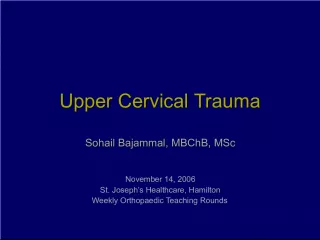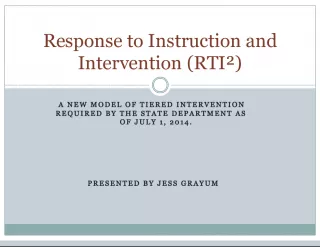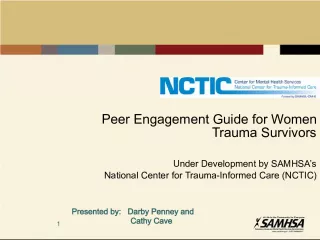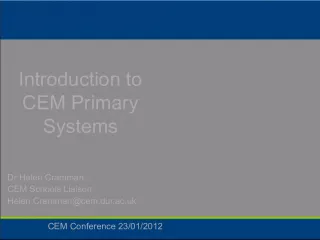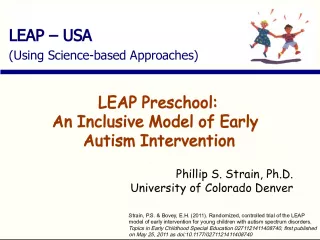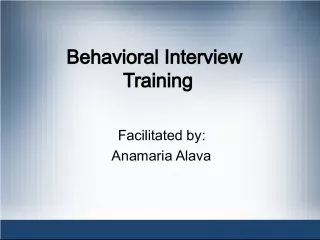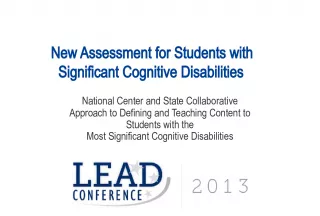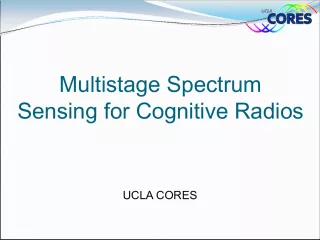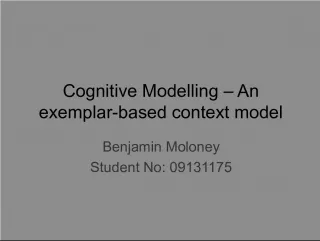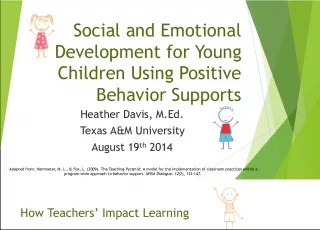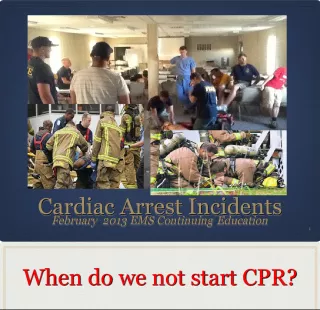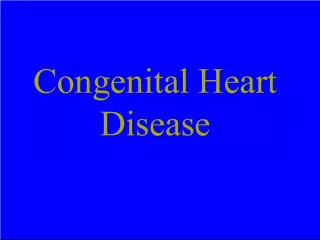Cognitive Behavioral Intervention for Trauma in Schools (CBITS)


This article explores the necessity of trauma programs in schools to address the public health emergency of interpersonal violence. It highlights the significance of this issue as identified by C. Everett Koop in JAMA 1992.
- Uploaded on | 5 Views
-
 sophiahaley
sophiahaley
About Cognitive Behavioral Intervention for Trauma in Schools (CBITS)
PowerPoint presentation about 'Cognitive Behavioral Intervention for Trauma in Schools (CBITS)'. This presentation describes the topic on This article explores the necessity of trauma programs in schools to address the public health emergency of interpersonal violence. It highlights the significance of this issue as identified by C. Everett Koop in JAMA 1992.. The key topics included in this slideshow are Cognitive Behavioral Intervention, Trauma, Schools, CBITS, Interpersonal Violence,. Download this presentation absolutely free.
Presentation Transcript
1. Cognitive Behavioral Cognitive Behavioral Intervention for Trauma Intervention for Trauma In Schools (CBITS) In Schools (CBITS)
2. Part 1: Why a trauma program in schools? Part 1: Why a trauma program in schools?
3. Interpersonal violence Interpersonal violence is a public health emergency and is a public health emergency and one of the most significant one of the most significant public health issues facing America C. Everett Koop, JAMA, 1992 public health issues facing America C. Everett Koop, JAMA, 1992
4. Some children are at greater risk for violence exposure Some children are at greater risk for violence exposure Males Males Older children Older children Early conduct problems Early conduct problems Living in urban areas Living in urban areas Lower socio-economic status Lower socio-economic status Schwab-Stone, 1995, 1999
5. Why a program for traumatized students? Why a program for traumatized students? One night several years ago, I saw men shooting at each other, people running to hide. I was scared and I thought I was going to die. After this happened, I started to have nightmares. I felt scared all the time. I couldnt concentrate in class like before. I had thoughts that something bad could happen to me. I started to get in a lot of fights at school and with my siblings. One night several years ago, I saw men shooting at each other, people running to hide. I was scared and I thought I was going to die. After this happened, I started to have nightmares. I felt scared all the time. I couldnt concentrate in class like before. I had thoughts that something bad could happen to me. I started to get in a lot of fights at school and with my siblings. Martin, 6th grader Martin, 6th grader
6. Consequences of violence exposure Consequences of violence exposure Post traumatic stress disorder (PTSD) Post traumatic stress disorder (PTSD) Re-experiencing Re-experiencing Numbing/Avoidance Numbing/Avoidance Hyperarousal Hyperarousal Prevalence in adolescents Prevalence in adolescents 4% of boys 4% of boys 6% of girls 6% of girls 75% of those with PTSD have additional mental health problem 75% of those with PTSD have additional mental health problem Breslau et al., 1991 ; Kilpatrick 2003, Horowitz, Weine & Jekel, 1995
7. Consequences of violence exposure Consequences of violence exposure Post traumatic stress disorder (PTSD) Post traumatic stress disorder (PTSD) Depression Depression Substance abuse Substance abuse Behavioral problems Behavioral problems Poor school performance Poor school performance
8. How does violence exposure impact learning? How does violence exposure impact learning? Decreased IQ and reading ability (Delaney-Black et al., 2003) Decreased IQ and reading ability (Delaney-Black et al., 2003) Lower grade-point average (Hurt et al., 2001) Lower grade-point average (Hurt et al., 2001) More days of school absence (Hurt et al., 2001) More days of school absence (Hurt et al., 2001) Decreased rates of high school graduation (Grogger, 1997) Decreased rates of high school graduation (Grogger, 1997) Increased expulsions and suspensions (LAUSD Survey) Increased expulsions and suspensions (LAUSD Survey)
9. How did this program come about? How did this program come about? Concerned with the impact of violence on students, Los Angeles Unified School District officials wanted an effective program for traumatized students Concerned with the impact of violence on students, Los Angeles Unified School District officials wanted an effective program for traumatized students Based on the best available science Based on the best available science Tailored for the school setting Tailored for the school setting Designed for children and families of diverse ethnic and social backgrounds Designed for children and families of diverse ethnic and social backgrounds
10. CBITS Program CBITS Program 10 child group therapy sessions for trauma symptoms 10 child group therapy sessions for trauma symptoms 1-3 individual child sessions for exposure to trauma memory and treatment planning 1-3 individual child sessions for exposure to trauma memory and treatment planning Parent outreach, 2 sessions on education about trauma, parenting support Parent outreach, 2 sessions on education about trauma, parenting support 1 teacher session including education about detecting and supporting traumatized students (1 session) 1 teacher session including education about detecting and supporting traumatized students (1 session)
11. Goals of CBITS Goals of CBITS Symptom Reduction Symptom Reduction PTSD symptoms PTSD symptoms General anxiety General anxiety Depressive symptoms Depressive symptoms Low self-esteem Low self-esteem Behavioral problems Behavioral problems Aggressive and impulsive Aggressive and impulsive Build Resilience Build Resilience Peer and Parent Support Peer and Parent Support
12. Part 2: Does it work? Part 2: Does it work?
13. High rates of violence exposure in LAUSD 6th grade students High rates of violence exposure in LAUSD 6th grade students Type of exposure reported 0% 20% 40% 60% 80% 100% Witnessed violence Victimization Knife or gun involved
14. Type of exposure reported Symptoms Screening also identified many children with clinical symptoms Screening also identified many children with clinical symptoms
15. Results Results PTSD and Depressive symptoms decreased PTSD and Depressive symptoms decreased Grades and classroom behavior improved Grades and classroom behavior improved As trauma symptoms decreased, grades improved As trauma symptoms decreased, grades improved Teachers reported fewer classroom learning problems after program Teachers reported fewer classroom learning problems after program Parents reported overall improved behavior and functioning Parents reported overall improved behavior and functioning
16. What did students say? What did students say? The group helped me because I dont have nightmares about that anymore. I dont think about what happened anymore. Even though I was nervous when I shared this in the group, I felt much better after that. It helps kids concentrate better in class and improve their grades like I did and get along with their teachers The group helped me because I dont have nightmares about that anymore. I dont think about what happened anymore. Even though I was nervous when I shared this in the group, I felt much better after that. It helps kids concentrate better in class and improve their grades like I did and get along with their teachers Martin Martin
17. What did families say? What did families say? My son is not afraid to come to school anymore he comes home and talks to me. Before he would just cry and not say anything. Now hell come home and tell us whats bothering him. I realize how important it is to spend time with our kids and listen to them. My son is not afraid to come to school anymore he comes home and talks to me. Before he would just cry and not say anything. Now hell come home and tell us whats bothering him. I realize how important it is to spend time with our kids and listen to them. Martins mother Martins mother
18. What did teachers say? What did teachers say? I was surprised that so many students qualified for the program. I was surprised that so many students qualified for the program. Initially, I was concerned because students would be pulled out of class they werent going to do as well. But then you could see them settling down and doing better. Initially, I was concerned because students would be pulled out of class they werent going to do as well. But then you could see them settling down and doing better. Ive noticed that after the program, students just seem more comfortable in class. And because they are more comfortable, they behave better and do better in class. Ive noticed that after the program, students just seem more comfortable in class. And because they are more comfortable, they behave better and do better in class.
19. Part 3: How do we Screen? Part 3: How do we Screen?
20. How do we screen students for CBITS? How do we screen students for CBITS? Step 1. Administer screening surveys to class-sized groups Step 1. Administer screening surveys to class-sized groups The screener includes: The screener includes: Shortened Life Events Scale: 9 items asking about violent events Shortened Life Events Scale: 9 items asking about violent events Foas Child PTSD Symptom Scale : 17 items Foas Child PTSD Symptom Scale : 17 items Screening should be conducted as close to first CBITS session as possible (within 1-2 months ) Screening should be conducted as close to first CBITS session as possible (within 1-2 months )
21. How do we screen students for CBITS? How do we screen students for CBITS? Step 2. Score screener to identify eligible students for CBITS Step 2. Score screener to identify eligible students for CBITS Life Events cut-off score: 3 or more points OR any weapon-related event Life Events cut-off score: 3 or more points OR any weapon-related event PTSD cut-off score: 14 or more points PTSD cut-off score: 14 or more points
22. How do we screen students for CBITS? How do we screen students for CBITS? Step 3. Interview eligible students individually Step 3. Interview eligible students individually Verify survey results and identify main traumatic event Verify survey results and identify main traumatic event Assess appropriateness for group Assess appropriateness for group
23. Part 4: CBITS Step by Step Part 4: CBITS Step by Step
24. Materials Needed Materials Needed Required Supplies Required Supplies -Group leader Manual -Group leader Manual -Student activity worksheets -Student activity worksheets Optional supplies Optional supplies -Chalkboard/large writing pad -Chalkboard/large writing pad -Crayons, Markers, Color pencils -Crayons, Markers, Color pencils
25. CBT: Friend or Foe? CBT: Friend or Foe? Assumptions about Cognitive Behavioral Therapy Assumptions about Cognitive Behavioral Therapy Concerns about Manualized Interventions Concerns about Manualized Interventions CBT in school setting: CBT in school setting: Acceptable Acceptable Feasible Feasible Amenable to group structure Amenable to group structure Focus on building skill Focus on building skill Empowering Empowering
26. Traumatic Event(s) Impairment PTSD symptoms Depressive symptoms Behavioral problems Social dysfunction School dysfunction CBITS Targets of CBITS Coping skills Parent & peer support Cognitions / Attributions Long Term Adjustment Problems PTSD Depression Violent Behavior Substance Use A Conceptual Model of the CBITS Program
27. Introduction to the Group (Session 1) Includes: M&M game for warm-up Introduction to the group rationale Discussion of confidentiality Beginning of any group management techniques such as Reward chart for good behavior Group rules Goals Worksheet
28. Conceptual model for participants (Session 1) What we think How we feel What we do Stress or Trauma
29. Thoughts Behaviors Feelings
30. Tailoring CBT Treatment Each Channel addressed with specific interventions Feelings/Physio. Arousal ---- Relaxation Thoughts ---- Cognitive Restructuring Behaviors: Avoidance ---- Exposure Impulsive (social problem solving)
31. Psychoeducation about trauma and symptoms (Session 2) Psychoeducation about trauma and symptoms (Session 2) Why? Why? To reduce stigma about trauma symptoms To reduce stigma about trauma symptoms To build peer and parent support To build peer and parent support To increase parent-child communication about problems To increase parent-child communication about problems How? How? Structured group discussion about symptoms Structured group discussion about symptoms Handouts sent home about symptoms Handouts sent home about symptoms Homework assignment to discuss with parents Homework assignment to discuss with parents
32. Pitfalls Pitfalls Pathologizing Pathologizing Embarrassing students with extreme symptoms Embarrassing students with extreme symptoms Need to keep tone educational and stress commonalities across students Need to keep tone educational and stress commonalities across students Psychoeducation about trauma and symptoms (Session 2) Psychoeducation about trauma and symptoms (Session 2)
33. Relaxation training & fear thermometer (Session 2) Relaxation training & fear thermometer (Session 2) Why? Why? To enable child to reduce anxiety To enable child to reduce anxiety To enable child to observe his or her own anxiety level To enable child to observe his or her own anxiety level To introduce a common language in describing fear or anxiety To introduce a common language in describing fear or anxiety How? How? Exercise combining positive imagery, slow breathing, and muscle relaxation Exercise combining positive imagery, slow breathing, and muscle relaxation Fear thermometer used throughout the groups Fear thermometer used throughout the groups Homework assignment to practice at home Homework assignment to practice at home
34. The Fear Thermometer The Fear Thermometer 10 8 Walking home from school alone Very anxious Not anxious at all 3 Going out on playground at recess 7 6 5 4 2 9 1
35. Relaxation training & fear thermometer (Session 2) Relaxation training & fear thermometer (Session 2) Pitfalls Pitfalls Rarely students feel panicky during exercise Rarely students feel panicky during exercise Giggling Giggling Explain that youll move around the room, check in with students, perhaps touch them on the shoulder to check in. Warn them that it sometimes seems funny. Explain that youll move around the room, check in with students, perhaps touch them on the shoulder to check in. Warn them that it sometimes seems funny. Demonstration and Activity Demonstration and Activity
36. Group Activity 1. What are your body clues when you are feeling anxious? 2. Think of TWO different triggers that make you feel anxious Fear Rating 3-4 Fear Rating 7-8 3. What things do you do to help you relax/cope..?
37. Cognitive therapy (Sessions 3 & 4) Cognitive therapy (Sessions 3 & 4) Why? Why? To increase childrens ability to observe their own thoughts and interpretations, and to challenge ones that are getting in their way To increase childrens ability to observe their own thoughts and interpretations, and to challenge ones that are getting in their way Focus is on thoughts like, Focus is on thoughts like, The world is dangerous, I cant trust anyone The world is dangerous, I cant trust anyone I cant deal with things, what happened is my fault I cant deal with things, what happened is my fault How? How? Didactic and exercises (the Hot Seat) Didactic and exercises (the Hot Seat) Is there another way to look at this? Is there anything I can do about this? How do I know this is true? catastrophic fears Is there another way to look at this? Is there anything I can do about this? How do I know this is true? catastrophic fears If this is true, whats the worst/best/most likely thing to happen? common fears If this is true, whats the worst/best/most likely thing to happen? common fears Lots of practice in session and on worksheets at home Lots of practice in session and on worksheets at home
39. Traumatic Event Post - Trauma Events Trauma Records It was not my fault, I handled it as well as could be expected. Post - Trauma Records Some but not all people can be trusted, PTSD symptoms are normal and temporary. SCHEMAS Self Schema I am mostly competent. World Schema The world is mostly safe. Pre - Trauma Records : Balanced, flexible premises about self and world RECOVERY From: Foa, E. B. & Jaycox, L. H. (1999.) Cognitive-behavioral treatment of post-traumatic stress disorder. In Spiegel, D. (Ed.) Efficacy and Cost-Effectiveness of Psychotherapy . Washington, DC: American Psychiatric Press.
40. Schematic model underlying pathology Traumatic Event Post - Trauma Events PATHOLOGY Trauma Records I failed, It is my fault, I deserve what happened. Post - Trauma Records People are untrustworthy, PTSD symptoms are dangerous. SCHEMAS Self Schema I am entirely incompetent. World Schema The world is entirely dangerous. Pre - Trauma Records: Extreme, rigid premises about self and world From: Foa, E. B. & Jaycox, L. H. (1999.) Cognitive-behavioral treatment of post-traumatic stress disorder. In Spiegel, D. (Ed.) Efficacy and Cost-Effectiveness of Psychotherapy . Washington, DC: American Psychiatric Press.
41. Cognitive therapy (Sessions 3 & 4) Cognitive therapy (Sessions 3 & 4) Pitfalls Pitfalls Too much focus on surface thoughts, not the ones that drive emotion Too much focus on surface thoughts, not the ones that drive emotion Need to look for thoughts that match emotion. Can keep an eye out for the most common maladaptive thoughts related to trauma Need to look for thoughts that match emotion. Can keep an eye out for the most common maladaptive thoughts related to trauma Could make students feel badly about the way they think Could make students feel badly about the way they think Continually normalize these kinds of thoughts, link them to traumatic event Continually normalize these kinds of thoughts, link them to traumatic event Demonstration Demonstration
42. Cognitive restructuring
43. ADAPTIVE COGNITIVE COPING THOUGHTS
44. Exposure: Processing the trauma memory [Individual Session(s)] Exposure: Processing the trauma memory [Individual Session(s)] Why? Why? To decrease anxiety when thinking about the trauma To decrease anxiety when thinking about the trauma To help child process or digest what happened to them To help child process or digest what happened to them To build parent and peer support and reduce stigma To build parent and peer support and reduce stigma How? How? Individual sessions in which child recounts the trauma Individual sessions in which child recounts the trauma Encouragement to talk about the trauma at home while the groups are running Encouragement to talk about the trauma at home while the groups are running
45. 0 1 2 3 4 5 6 7 8 9 1 0 Time FT Avoidance
46. 0 1 2 3 4 5 6 7 8 9 1 0 Time S U D S Exposure-Avoidance vs. Habituation
47. 0 1 2 3 4 5 6 7 8 9 1 0 Time S U D S Exposure-Habituation contd.
48. How to help students process the memory How to help students process the memory 1. Provide an example and rationale of why to do this 1. Provide an example and rationale of why to do this 2. Tell the student to tell the story of the trauma in movie-like details and take notes 2. Tell the student to tell the story of the trauma in movie-like details and take notes 2. Break down story into parts and ask student what he/she feels (NOW) at each part 2. Break down story into parts and ask student what he/she feels (NOW) at each part 3. Ask student to re-tell story, and get fear ratings for the 2-3 most bothersome parts. 3. Ask student to re-tell story, and get fear ratings for the 2-3 most bothersome parts. 4. Repeat until distress is reduced if possible, or schedule another meeting 4. Repeat until distress is reduced if possible, or schedule another meeting 5. Plan for disclosure and support in the group meetings (Sessions 6 and 7) 5. Plan for disclosure and support in the group meetings (Sessions 6 and 7)
49. Therapist Stance During Exposure Therapist Stance During Exposure Quiet Quiet Supportive / empathic Supportive / empathic Probing only as necessary to engage the student Probing only as necessary to engage the student Not asking whys or hows or trying to analyze what happened Not asking whys or hows or trying to analyze what happened
50. Exposure: Processing the trauma memory [Individual Session(s)] Exposure: Processing the trauma memory [Individual Session(s)] Pitfalls Pitfalls Student gets very upset, feels overwhelmed Student gets very upset, feels overwhelmed Therapist needs to take care to temper the experience (e.g., fast forward) for the student and normalize upset Therapist needs to take care to temper the experience (e.g., fast forward) for the student and normalize upset Student feels nothing, shuts down Student feels nothing, shuts down Therapist can ask for more detail, find ways to engage student. But in early intervention group approach, not necessary to dig up the trauma if there is little distress. Therapist can ask for more detail, find ways to engage student. But in early intervention group approach, not necessary to dig up the trauma if there is little distress.
51. Approaching anxiety-provoking situations(Session 5) Approaching anxiety-provoking situations(Session 5) Why? Why? To teach children that anxiety does not last forever To teach children that anxiety does not last forever To get children able to do all the things they want and need to do To get children able to do all the things they want and need to do To build confidence To build confidence How? How? Identify things children are avoiding related to the trauma, that are safe to do Identify things children are avoiding related to the trauma, that are safe to do Make a plan for decreasing that avoidance Make a plan for decreasing that avoidance Practice approaching those situations and staying long enough for anxiety to decrease or go away Practice approaching those situations and staying long enough for anxiety to decrease or go away
52. Anxiety fear hierarchy Anxiety fear hierarchy Situation Rating Situation Rating Going to the park alone 10 Going to the park alone 10 Going to the park with friends 8 Going to the park with friends 8 Going to the park with parents 6 Going to the park with parents 6 Playing outside alone 6 Playing outside alone 6 Playing outside w/ brother 5 Playing outside w/ brother 5 Seeing best friend 4 Seeing best friend 4 Going to different park 4 Going to different park 4 Driving past park 2 Driving past park 2 Least Scared/Upset Most Scared/Upset 10 9 8 7 6 5 4 3 2 1 Fear Hierarchy Fear Thermometer
53. Approaching anxiety-provoking situations (Session 5) Approaching anxiety-provoking situations (Session 5) Pitfalls Pitfalls Does not apply to all students Does not apply to all students Focus on this with avoidant students. For non-avoidant students, put other useful things on their hierarchy (e.g., talking in front of class) Focus on this with avoidant students. For non-avoidant students, put other useful things on their hierarchy (e.g., talking in front of class) Parents do not support homework Parents do not support homework Work with parents on their own anxiety and avoidance, find a motivator for them to get things back to normal at home Work with parents on their own anxiety and avoidance, find a motivator for them to get things back to normal at home It is too dangerous to approach these activities It is too dangerous to approach these activities Dangerous situations should not be attempted. Instead, find ways to make them safe (vary time of day, alone or with others, location) Dangerous situations should not be attempted. Instead, find ways to make them safe (vary time of day, alone or with others, location) They get more anxious, not less They get more anxious, not less Careful planning is crucial Careful planning is crucial
56. Exposure: Processing the trauma memory (Sessions 6 & 7) Exposure: Processing the trauma memory (Sessions 6 & 7) Why? Why? To decrease anxiety when thinking about the trauma To decrease anxiety when thinking about the trauma To help child process or digest what happened to them To help child process or digest what happened to them To build parent and peer support and reduce stigma To build parent and peer support and reduce stigma How? How? Group sessions in which the child draws pictures or tells others about the trauma Group sessions in which the child draws pictures or tells others about the trauma Builds upon Individual Session Work Builds upon Individual Session Work Encouragement to talk about the trauma at home while the groups are running Encouragement to talk about the trauma at home while the groups are running Imaginal, Pictorial, & Verbal exposures Imaginal, Pictorial, & Verbal exposures
57. Social problem-solving (Sessions 8 & 9) Social problem-solving (Sessions 8 & 9) Why? Why? To decrease impulsive reactions and decisions To decrease impulsive reactions and decisions To improve real-life problems To improve real-life problems To build skills in handling future problems To build skills in handling future problems How? How? Teach children the link between thoughts and actions Teach children the link between thoughts and actions Teach children to brainstorm solutions to a problem Teach children to brainstorm solutions to a problem Teach children to weigh the pluses and minuses or pros and cons for possible actions Teach children to weigh the pluses and minuses or pros and cons for possible actions Practice in group with real problems and worksheets at home Practice in group with real problems and worksheets at home
58. Social problem-solving (Sessions 8 & 9) Social problem-solving (Sessions 8 & 9) Pitfalls Pitfalls Get stuck on a complicated problem. Get stuck on a complicated problem. Work on just a part of the problem. Pick examples carefully. Work on just a part of the problem. Pick examples carefully. Seems impossible to solve this one. Seems impossible to solve this one. Therapist can examine own negative thoughts! Can always put information- gathering, seeking social support on the list of solutions. Therapist can examine own negative thoughts! Can always put information- gathering, seeking social support on the list of solutions.
59. Graduation/Relapse Prevention (Session 10) Graduation/Relapse Prevention (Session 10) Certificates Certificates Celebration of Progress Celebration of Progress Special activity/food/party Special activity/food/party Troubleshooting and applying CBITS skills to upcoming stressors Troubleshooting and applying CBITS skills to upcoming stressors
60. Other Treatment Issues Other Treatment Issues Inclusion/Exclusion Criteria Inclusion/Exclusion Criteria Referrals Referrals Reinforcement/Rewards Reinforcement/Rewards Homework Homework Missed Sessions Missed Sessions
61. Parent and Teacher education sessions Parent and Teacher education sessions Parent Education Sessions Parent Education Sessions 2 sessions related to CBITS 2 sessions related to CBITS Cover the 6 main techniques Cover the 6 main techniques 2 sessions relevant to other parent concerns 2 sessions relevant to other parent concerns Teacher Education Sessions Teacher Education Sessions Overview of CBITS program Overview of CBITS program Tips for working with traumatized youth Tips for working with traumatized youth
62. Part 5: Next Steps for CBITS Implementation Part 5: Next Steps for CBITS Implementation
63. Gaining support from the school administration Gaining support from the school administration First meeting with the Principal First meeting with the Principal Discuss the impact of PTSD in terms relevant to educators Discuss the impact of PTSD in terms relevant to educators Academic achievement Academic achievement Grades and standardized tests Grades and standardized tests Emotionally Disabled (ED) Students and IDEA Emotionally Disabled (ED) Students and IDEA Improving classroom behavior and performance Improving classroom behavior and performance Coordinate with other relevant services on campus Coordinate with other relevant services on campus
64. Gaining support from school community Gaining support from school community Liaison with teachers Liaison with teachers Find ideal time for group Find ideal time for group Present education about trauma to teachers and respond to any concerns about program Present education about trauma to teachers and respond to any concerns about program Outreach to parents Outreach to parents Depending on community and school issues, consider working with parent leaders to engage parents in process Depending on community and school issues, consider working with parent leaders to engage parents in process Develop parent component depending on needs of parents Develop parent component depending on needs of parents
65. Forming CBITS groups Forming CBITS groups Screen about 60 students to form one group of 6-8 participants Screen about 60 students to form one group of 6-8 participants If there are multiple groups, consider age and gender in forming groups If there are multiple groups, consider age and gender in forming groups Start at the beginning of the quarter to make sure that there is time to screen, score, meet with eligible students individually, and complete the program (17-20 weeks) Start at the beginning of the quarter to make sure that there is time to screen, score, meet with eligible students individually, and complete the program (17-20 weeks)
